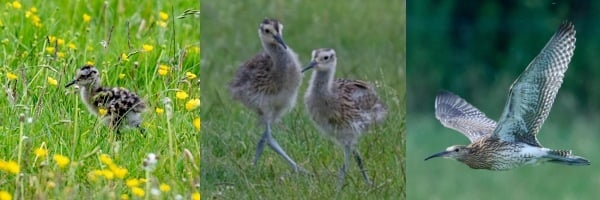

Save the last curlews of the Upper Thames

Curlews in the Upper Thames are on the brink and need our help. We are working with farmers and volunteers to turn their fortunes around.
💚💚Every pound you give to our campaign will be matched by the Aviva Community Fund and by the Trust for Oxfordshire’s Environment. This effectively trebles your generous donation.💚💚
https://www.crowdfunder.co.uk/p/help-us-save-the-last-curlews-of-the-upper-thames
With your help, our partnership can help protect the wetland habitat where Curlews come to breed and feed. These habitats are highly effective carbon sinks and provide natural flood defences – both extremely important in the fight to prevent and protect against the impacts of climate change.
A bird in a field of yellow flowers AI-generated content may be incorrect.A Curlew calls to its chicks in an Upper Thames meadow. Photo: Mark Hunter
🐣 Why Curlews Matter
"I take my gladness in the sound of the curlew instead of the laughter of men", The Seafarer - c.10th century Anglo-Saxon poem.
Curlews are an iconic bird species of the British landscape and their haunting call has inspired artists, poets and nature-lovers for generations. Yet Curlews are now a Red List species, meaning that they are at urgent risk of extinction. In just the last 20 years, the UK has lost half of its breeding population. The Upper Thames is home to 10% of the UK’s remaining lowland breeding population (just 60 breeding pairs), urgent action here can help ensure future generations can still hear the Curlew's call.
There is hope. Curlews return to the same breeding sites each year. With your help, we can give them a fighting chance by protecting the habitats in which they breed and feed.
Curlews are considered an “umbrella species”. Their conservation requires large areas of high-quality habitat to be protected and managed sympathetically, which also benefits many other species. And by conserving these habitats, we can safeguard entire ecosystems. In the Upper Thames, many of the other species to benefit are, like the Curlew, highly threatened. These include Lapwing, Skylark, Water Vole, Harvest Mouse and Narrow-leaved Water Dropwort (a rare flower of floodplain meadows).
The Curlew's breeding grounds are farmed grasslands, especially wet meadows and hay meadows. In recent years more extreme weather in spring, likely linked to climate change, has impacted on breeding success. Wet weather in 2024 caused some nests to be flooded and birds displaced away from the favoured nest sites and chicks became chilled in very wet grass. Conversely, hot and dry conditions in 2025 delayed the growth of grass making nests more obvious to predators and providing chicks with less cover. Our work will seek to mitigate these impacts in future years, working with farmers to deliver practical solutions which will secure the long-term future of Curlews in this landscape.
Two birds standing in water AI-generated content may be incorrect.
Two of the young Curlews that fledged successfully in 2025. Photo: Mark Hunter
An extremely important aspect of our project is collaborative working with farmers to provide the support needed to protect breeding birds and tweak land management, where needed, to help Curlews breed successfully. Our programme works in partnership to highlight and support farming practices that enhance the health of the land and soil, recognising their vital role as natural carbon stores.
With increasing engagement by farmers in conserving Curlews we can work towards expanding the habitats to increase the quality and capacity of the land to provide natural flood management benefits.
https://www.crowdfunder.co.uk/p/help-us-save-the-last-curlews-of-the-upper-thames
🌍 Our Vision
We want curlews once again to thrive in meadows and wetlands across the Upper Thames - their wonderful, evocative, calls echoing across the landscape each spring. We want to ensure that future generations can experience the joy of seeing and hearing these beautiful birds in the wild.
To achieve this, we must scale up our efforts—expanding to more river catchments, supporting more volunteers, and working with more farmers.
Two birds in a grassy field AI-generated content may be incorrect. Curlew chicks fledged from nests that the Partnership protected in 2025.
Photos: Mark Hunter
🌄Small Change, Big Impact
Every spring Curlews return to breed in wet pastures and hay meadows - often where generations of these wonderful birds have nested every year for decades. Sadly, many of these special places are no longer suitable for them to breed - often due to agricultural change and the building of new roads and housing.
Curlews thrive where sustainable farming practices enable the development of grasslands and soils packed with the Curlew's favourite food - the earthworm. These soils are also great at storing carbon and can help slow the flow of water during flood events - both extremely important in the fight to protect against the impacts of climate change.
In recent decades wet grasslands have been successfully restored by farmers and nature conservation charities in the Upper Thames. This project seeks to nurture these first 'green shoots' of Curlew recovery. Working in partnership with a network of organisations we will help farmers to protect this iconic wading bird breeding on their farm, providing advice and support for restoring and managing wet grassland and hay meadow habitats in a Curlew-friendly way.
Often small changes in land management can deliver big benefits to Curlews, for example - delaying a hay cut can help chicks survive; removing livestock from a field for a few week while they nest will improve the likelihood of a nest hatching.
💸 How We’ll Use Your Donations
We’re aiming to raise £25,000 to continue and expand our proven work. Your support will help us:
Take action by working with farmers, volunteers, and conservation groups
Facilitate farmers and volunteers to collaborate in helping their local Curlews
Provide training and essential equipment for volunteers and groups
Coordinate and sustain nest protection efforts
Expand our work to new breeding areas
Research and trial new methods to improve habitats, nest and chick protection
Raise additional funds to sustain the project long-term
🌿 About Us
This programme and campaign are led by Wild Oxfordshire, a charity dedicated to supporting nature recovery action 'on the ground’.
Match-funding and admin support comes from the Trust for Oxfordshire's Environment as part of its mission to help find funding to protect and restore nature and its habitats across Oxfordshire.
The Upper Thames Wader Group are a collective of volunteer fieldworkers, farmers, landowners, local groups and other interested individuals and organisations who work collaboratively on the ground to help wading birds, including the Curlew, to survive.
With extra funding this programme can allow us to develop this partnership further, with more local initiatives working to save the Curlews and to protect their habitats and the flood plains where they breed.
Our project works across the Upper Thames, centred in Oxfordshire and flowing across to neighbouring south Warwickshire and Buckinghamshire - Curlews don't recognise county boundaries!
🌿 What our partnership has achieved so far
Over the past five years, collectively, we have protected 110 nests using temporary electric fencing, resulting in a 74% hatching success rate—a huge improvement compared to the average hatching success of 25% for nests not protected in this way. Thanks to these efforts, 61 young curlews have successfully fledged.
There has been a collective approach to finessing the immediate need to protect the nests from predation by ground dwelling mammals and disturbance by grazing cattle and sheep.
Moving forward, this campaign will allow the project to work with more landowners to support changes in land management that will help Curlews breed successfully. With more farmers involved in the programme, Curlew nests can be located more quickly and the landowner can have prepared a plan of how to manage their farming to work around the six-week period after hatching until the young Curlews can fly confidently. Over time we will seek to ensure that more land can be managed for Curlews whilst also delivering increased carbon storage in soils and absorbing water during flood events.
🙏 Please Donate
Every pound helps us to develop relationships with the landowners and to protect more nests and give Curlew chicks a chance to survive and thrive. Together, we can bring the Curlew’s song back to meadows and marshes across the Upper Thames.
https://www.crowdfunder.co.uk/p/help-us-save-the-last-curlews-of-the-upper-thames